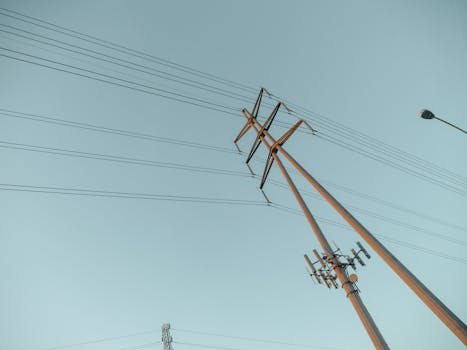“Maximize Efficiency: Essential Solar Wiring Tips for Cold Climates!”
When installing solar systems in cold climates, specific wiring considerations are essential to ensure optimal performance and longevity. Cold temperatures can affect the efficiency of solar panels and the integrity of electrical components. Proper insulation, the use of weather-resistant materials, and strategic placement of wiring can mitigate risks such as freezing, snow accumulation, and moisture intrusion. Additionally, understanding the impact of temperature on electrical resistance and ensuring adequate grounding and protection against ice buildup are crucial for maintaining system reliability. This guide provides essential tips for effectively wiring solar installations in cold environments, ensuring they operate efficiently year-round.
Proper Insulation Techniques for Solar Wiring
When it comes to installing solar wiring in cold climates, proper insulation techniques are crucial for ensuring the longevity and efficiency of the system. Cold weather can pose unique challenges, including the risk of freezing temperatures affecting the wiring and connections. Therefore, understanding how to effectively insulate solar wiring is essential for maintaining optimal performance throughout the winter months.
To begin with, selecting the right type of wire is fundamental. In cold climates, it is advisable to use wires that are specifically rated for low temperatures. These wires are often made from materials that remain flexible even in frigid conditions, reducing the risk of cracking or breaking. Additionally, using UV-resistant insulation can help protect the wiring from the sun’s rays during the warmer months, ensuring that the insulation does not degrade over time. This dual protection is vital for maintaining the integrity of the wiring system.
Once the appropriate wiring has been selected, the next step involves proper installation techniques. It is important to ensure that all connections are secure and well-insulated. Using heat-shrink tubing can provide an extra layer of protection against moisture and cold. This tubing shrinks when heat is applied, creating a tight seal around the connection points. Moreover, applying a high-quality electrical tape over the connections can further enhance insulation, preventing water ingress that could lead to corrosion or short circuits.
In addition to securing connections, it is essential to consider the routing of the wiring. When installing solar panels, it is advisable to run the wiring along the building’s structure, ideally in areas that are less exposed to the elements. For instance, placing wires under eaves or along walls can help shield them from snow accumulation and ice formation. Furthermore, using conduit can provide additional protection against physical damage and environmental factors. Rigid or flexible conduit can be employed depending on the specific installation needs, but both options offer a robust barrier against cold weather.
Another critical aspect of insulation is ensuring that the wiring is not in direct contact with cold surfaces. When wires are placed against uninsulated walls or roofs, they can lose heat rapidly, increasing the risk of freezing. To mitigate this, it is beneficial to use insulation sleeves or wraps around the wiring. These materials can help maintain a stable temperature, reducing the likelihood of ice formation and ensuring that the electrical flow remains uninterrupted.
Moreover, it is important to regularly inspect the solar wiring system, especially before the onset of winter. Checking for any signs of wear, damage, or moisture intrusion can help identify potential issues before they escalate. If any problems are detected, addressing them promptly can prevent costly repairs and ensure that the solar system operates efficiently throughout the cold months.
In conclusion, proper insulation techniques for solar wiring in cold climates are essential for maintaining system performance and longevity. By selecting the right materials, securing connections, routing wiring thoughtfully, and conducting regular inspections, homeowners can protect their solar investments from the harsh effects of winter weather. Ultimately, these proactive measures not only enhance the reliability of the solar system but also contribute to its overall efficiency, ensuring that it continues to provide renewable energy even in the coldest conditions.
Choosing the Right Materials for Cold Weather

When it comes to installing solar systems in cold climates, selecting the right materials is crucial for ensuring optimal performance and longevity. Cold weather can pose unique challenges, such as increased risk of snow accumulation, ice formation, and temperature fluctuations, all of which can affect the efficiency of solar panels and the integrity of the wiring. Therefore, understanding the specific requirements for materials in these environments is essential for any solar installation.
First and foremost, the choice of solar panels is paramount. In cold climates, it is advisable to opt for panels that are specifically designed to withstand harsh weather conditions. Monocrystalline panels, for instance, tend to perform better in low-light conditions and can generate electricity even in overcast weather, making them a suitable choice for regions that experience long winters. Additionally, look for panels with a high snow load rating, as this indicates their ability to endure the weight of accumulated snow without sustaining damage.
Equally important is the selection of wiring materials. In cold climates, using high-quality, weather-resistant wiring is essential to prevent issues such as cracking or brittleness that can occur with lower-grade materials. Copper wiring is often recommended due to its excellent conductivity and resistance to corrosion. However, it is crucial to ensure that the insulation on the wiring is rated for low temperatures. This will help maintain flexibility and prevent the insulation from becoming brittle, which can lead to electrical failures.
Moreover, the use of appropriate connectors and junction boxes cannot be overlooked. In cold weather, connectors should be designed to resist moisture and prevent corrosion, as water can freeze and expand, potentially causing damage. Look for connectors that are rated for outdoor use and have features such as sealing gaskets to keep moisture out. Similarly, junction boxes should be made from durable materials that can withstand extreme temperatures and should be installed in locations that minimize exposure to snow and ice.
In addition to selecting the right materials, proper installation techniques are vital for ensuring the longevity of the solar system in cold climates. For instance, mounting systems should be securely fastened to withstand high winds and heavy snow loads. It is also advisable to install panels at an angle that allows snow to slide off easily, reducing the risk of accumulation that could hinder performance. Furthermore, ensuring that all wiring is properly secured and protected from potential damage caused by falling snow or ice is essential.
Finally, regular maintenance is key to keeping a solar system functioning optimally in cold weather. This includes clearing snow off the panels when necessary, checking for any signs of wear or damage in the wiring and connectors, and ensuring that all components are functioning as intended. By being proactive about maintenance, homeowners can extend the life of their solar systems and maximize their energy production, even in the coldest months.
In conclusion, choosing the right materials for solar installations in cold climates is a multifaceted process that requires careful consideration of panel types, wiring quality, and installation techniques. By prioritizing durability and performance, homeowners can ensure that their solar systems remain efficient and reliable, regardless of the weather conditions. With the right approach, solar energy can be a viable and sustainable option even in the harshest of climates.
Best Practices for Protecting Solar Cables from Freezing
When installing solar systems in cold climates, one of the most critical considerations is the protection of solar cables from freezing temperatures. The integrity of these cables is essential for the efficient operation of solar panels, and neglecting their protection can lead to significant performance issues and costly repairs. To ensure that your solar installation remains functional and reliable throughout the winter months, it is vital to implement best practices for safeguarding these components.
First and foremost, selecting the right type of cable is crucial. In cold climates, it is advisable to use cables specifically designed for low-temperature environments. These cables are often made from materials that remain flexible and resilient even in frigid conditions, reducing the risk of cracking or breaking. Additionally, look for cables that are UV-resistant and have a durable outer sheath to protect against environmental factors such as snow, ice, and wind.
Once the appropriate cables are chosen, proper installation techniques become paramount. One effective method is to bury the cables below the frost line, which varies by region but typically ranges from 18 to 48 inches deep. This depth helps to insulate the cables from extreme surface temperatures, preventing them from freezing. When burying cables, it is also essential to use conduit to protect them from physical damage and moisture infiltration. PVC or rigid metal conduit can provide an extra layer of protection, ensuring that the cables remain intact and functional.
In addition to burying cables, consider the routing of the cables during installation. Avoid running cables along the surface of roofs or other exposed areas where they are more susceptible to freezing temperatures. Instead, route them through insulated spaces, such as attics or walls, where they can benefit from the ambient warmth of the building. This practice not only protects the cables from freezing but also minimizes the risk of snow accumulation and ice formation that could lead to physical damage.
Furthermore, it is essential to regularly inspect the solar installation, especially after severe weather events. Snow and ice can accumulate on solar panels, and as they melt, water can seep into connections and junction boxes. Ensuring that these areas are sealed and protected from moisture is vital for preventing corrosion and electrical failures. Additionally, consider using heat tape or heating cables on critical junction points to provide extra warmth during extreme cold spells. This can help to prevent ice buildup and ensure that connections remain secure and functional.
Moreover, proper maintenance of the solar system is crucial for long-term performance. Regularly clearing snow and ice from solar panels not only maximizes energy production but also prevents excess weight from damaging the panels and their associated wiring. It is advisable to use a soft brush or a snow rake designed for solar panels to avoid scratching the surface.
In conclusion, protecting solar cables from freezing in cold climates requires a combination of careful material selection, strategic installation practices, and ongoing maintenance. By implementing these best practices, solar system owners can ensure that their installations remain efficient and reliable, even in the harshest winter conditions. With the right precautions in place, solar energy can continue to be a viable and sustainable power source, regardless of the weather.
Optimizing Solar Panel Placement in Snow-Prone Areas
When considering solar panel installation in snow-prone areas, optimizing placement is crucial for maximizing energy production and ensuring the longevity of the system. The unique challenges posed by cold climates, particularly the accumulation of snow and ice, necessitate a strategic approach to positioning solar panels. One of the primary factors to consider is the angle of the panels. In regions that experience heavy snowfall, a steeper tilt can be beneficial. This inclination not only helps in shedding snow more effectively but also allows for better sunlight exposure during the winter months when the sun is lower in the sky.
Moreover, the orientation of the panels plays a significant role in their efficiency. Ideally, solar panels should face true south in the Northern Hemisphere to capture the maximum amount of sunlight throughout the day. However, in areas with frequent snow cover, it may be advantageous to adjust the orientation slightly to account for local weather patterns and shading from nearby trees or buildings. This adjustment can enhance energy production, especially during the critical winter months when solar energy is most needed.
In addition to tilt and orientation, the choice of mounting system is essential for optimizing solar panel placement in cold climates. Ground-mounted systems can be advantageous, as they allow for easier access for maintenance and snow removal. However, roof-mounted systems are often more common due to space constraints. When opting for roof-mounted panels, it is vital to ensure that the roof structure can support the additional weight of the panels, especially when snow accumulates. Furthermore, using a mounting system that allows for a higher clearance can help prevent snow from piling up directly on the panels, thereby enhancing their efficiency.
Another important consideration is the type of solar panels used. Monocrystalline panels, known for their high efficiency and performance in low-light conditions, can be particularly effective in cold climates. These panels tend to perform better than their polycrystalline counterparts in cooler temperatures, making them a suitable choice for regions that experience harsh winters. Additionally, investing in panels with anti-reflective coatings can further improve energy capture by reducing the amount of light that bounces off the surface, which is especially beneficial in snowy conditions where glare can be an issue.
Furthermore, regular maintenance is essential to ensure optimal performance of solar panels in snow-prone areas. Homeowners should be proactive in monitoring snow accumulation and removing it when necessary. While it may be tempting to use shovels or other tools, it is crucial to exercise caution to avoid damaging the panels. Instead, using a soft broom or a specialized snow rake designed for solar panels can help safely clear snow without risking harm to the system.
In conclusion, optimizing solar panel placement in snow-prone areas involves a multifaceted approach that considers tilt, orientation, mounting systems, panel selection, and maintenance practices. By carefully addressing these factors, homeowners can significantly enhance the efficiency and effectiveness of their solar energy systems, ensuring that they continue to generate power even in the coldest months of the year. As the demand for renewable energy sources grows, understanding how to adapt solar technology to various climates will be essential for maximizing its potential and contributing to a more sustainable future.
Q&A
1. **Question:** What type of solar panels are best for cold climates?
**Answer:** Monocrystalline solar panels are generally more efficient in cold temperatures and perform better in low-light conditions compared to other types.
2. **Question:** How should solar panels be installed to prevent snow accumulation?
**Answer:** Install solar panels at a steeper angle (30-45 degrees) to allow snow to slide off more easily and reduce the risk of damage.
3. **Question:** What wiring considerations should be made for solar systems in cold climates?
**Answer:** Use UV-resistant and cold-rated wiring to prevent brittleness and ensure reliable performance in low temperatures.
4. **Question:** How can battery performance be optimized in cold weather for solar systems?
**Answer:** Insulate battery storage areas and consider using lithium-ion batteries, which perform better in cold conditions compared to lead-acid batteries.
Conclusion
In conclusion, when installing solar wiring in cold climates, it is essential to use materials that can withstand low temperatures, ensure proper insulation to prevent heat loss, and implement strategies to minimize snow accumulation on panels. Additionally, using weather-resistant connectors and ensuring proper grounding can enhance system reliability and performance in harsh conditions. Regular maintenance and monitoring are also crucial to address any issues that may arise due to extreme weather.




